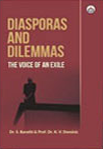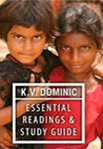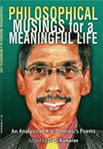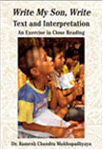Book Details
Diasporas and Dilemmas: The Voice of an Exile – Edited by Dr. S. Barathi & Prof. Dr. K. V. Dominic
Year Of Publish:

Diasporas and Dilemmas: The Voice of an Exile
Edited by
Dr. S. Barathi & Prof. Dr. K. V. Dominic
Acknowledgments
I thank God Almighty for giving me the confidence to carry out the task of editing this book. My profound thanks to Dr K. V. Dominic for his mentoring, constant support and motivation, also for providing me an opportunity to edit this book on diaspora literature. I thank all the contributors for this book and especially my colleagues at Srinivasa Ramanujan Centre, SASTRA University for rendering me assistance throughout this endeavour. My sincere thanks are due to Mr. Sudarshan Kcherry of Authorspress without whom this book might not have been possible.
–Dr. S. Barathi
Preface
Diaspora literature has become more popular in the 21st century. The works of diaspora has been recognised as early as in the 19th century and continues to attract the attention of the readers due to its varied theme and contents. Diaspora as a separate stream of studies has opened a new window to researchers and at present in the Western countries academicians concentrate more on diaspora studies. It has become a separate discipline. Most of the diaspora writers had enriched literature by interlinking the complexity of their culture with that of the alien land in which they had settled. Their works represent colourful spectrum of various genres that range from immigrant sensibility to cultural adaptability. There are various theories to study diaspora literature. The hybridity theory by Homi Bhabha is the traditional theory used to analyse sense of alienation, loss and immigrant sensibility in diaspora writings. The other theorists include Gayatri Spivak, Paul Gilroy and Edward Said who had focused the theory of diaspora and postcolonial studies. Their theories had paved way to unleash the various cultures and new methods of thinking beyond the confines of a notion.
The term ‘diaspora’ is derived from the Greek root words ‘Speiro’ which means to sow and ‘dia’ means over. The various diaspora writings include Indian, Srilankan, Carriebean, African, Asian–which includes the writings of Afghan, Chinese, Japanese, Korean, Indonesian writers settled in the West especially in the countries like the US, Australia, Canada, France, England, etc. Majority of the writers of Indian origin like Anita Desai, Kiran Desai, Bharati Mukherjee, Jumpha Lahiri, Chitra Banerjee Divakaruni, Meena Alexander had settled down in the US. Whereas a few others of Indian diaspora writers like Sujata Bhat Germany, Debjani Chaterjee, Salman Rushdie and Vikram Seth in England, Stephen Gill in Canada represented the values of Indian tradition and customs through their works. These writers in the alien land reflect Indian psyche in the alien situation and they symbolise their native countries through nostalgia, challenges faced by immigrants in the foreign country. Almost all these writers had autobiographical elements in their works. The contemporary diaspora writers have developed a distinctive voice asserting their autonomy.
Here it is worthy to note the difference between diaspora and exile. Diaspora stands for oue’s warm attachment towards the homeland and toward the migration. Exile emphasizes the forced nature of the migration and the freshness of the experience of leaving the homeland; exile is not neutral and exiled peoples usually possess a single-minded desire to return to their homeland. Time is also a factor: exilic literature may be written during the Babylonian exile of the sixth century B.C.E., when the experience and memory of it was still vivid.
The main objective of this book is to analyse the voice of diaspora writers in various perspectives. Majority of the research papers are focussed on Indian diaspora particularly writers like Chitra Banerjee Divakaruni and Stephen Gill. There are wide varieties of techniques applied to the works ranging from Genette’s narratology, feminism, cultural adaptability, to latest theories like cultural materialism and discourse analysis.
There are sixteen articles in this book dealing with various issues and techniques of diaspora writers. The book is divided into five chapters based on the theme of the articles. The first chapter is titled as Diaspora Discourse which deals with narrative techniques used in diaspora literature. There are four research articles categorised under this chapter. In this chapter the first article co-authored by K. Abirami and E. Koperundevi titled “From Calcutta to California: An Analysis of Chitra Banerjee Divakaruni’s ‘Mrs. Dutta writes a letter’” depicts the importance of narration and how diaspora narration is different from others. The researchers had applied William Labov’s model to analyse the story and it highlights the challenges faced by an immigrant in an alien land. It also explains the plight of the elderly in adapting to changes and motivates the readers to accept change and overcome challenges.
The second article “An Application of Gerard Genette’s Narratology in The Mistress of Spices” by R. Thenmozhi and K. Abirami has applied Genette’s narrative technique to focus on the distinctive writing style of Divakaruni, thus bringing out her distinctive voice. This research article tries to bring out the different narrative techniques used by the author for different situations to create an effect that the author wanted to bring in the mind of the readers and tries to establish the artistic merit of Chitra Banerjee Divakaruni.
The third article in this chapter by S. Bavetra entitled “A Semiotic Analysis of “Pathan Soldier” by Stephen Gill” applies the semiotic codes devised by Roland Barthes to identify the narrative structure of the text. Through the application of Barthes’ codes the writer had brought the essential characters of Stephen Gill’s writings. It also tries to prove that the story is intertwined with the five codes namely the Proairetic, Hermeneutic, Semantic, Symbolic and Cultural codes. This analysis can give an insight into the theme and the structure of the story.
The fourth article in this chapter “A Stylistic Analysis of Meena Alexander’s ‘The Color Home’” by K Sunanda examines the aspects of graphology, syntax, semantics, and phonology in “The Color Home” from the anthology Raw Silk. This analysis would probably help the readers to understand the basic concepts, structural elements, tones used to explain the diaspora world.
The second Chapter Diasporic Sensibilty has three research papers on various Asian diapora writers. The fifth article co-authored by Syed Mir Hassim and M Revathi titled “The Symbols of Disjointed and Disfigured Entities in the Short-fiction of Alice Munro & Mavis” argues against the adverse effects of globalisation that have been worsening the plight of women on account of physical and psychological violence against them, degradation of their living conditions and habitual unfairness towards them.
The next article in this chapter is on “Textualizing the Ambivalent Immigrant: A Reading of Monica Ali’s Brick Lane” by Samijila T H, Soumya Jose and Sony Jalarajan Raj endeavours to delineate the ambivalence of the protagonist in Monica Ali’s novel, Brick Lane and also focuses on how epistolary mode of narration has helped the novelist to expose the inner conflict of the protagonist.
- Vidya’s article on “Archana Painuly’s Where Do I Belong? An Exegesis of Diasporic Consciousness”explores the themes of the complexities of the immigrant experience and foreignness, the class of assimilation, the tangled ties between generations and portrait of an Indian family torn between the pull of respecting family traditions and the Danish way of life.
The third Chapter is titled Diaspora Themes and has four research articles under this category. It has themes of feminism, female quest for identity, identity crisis and diaspora psyche.
Deen Dayal’s article “Unbeatable Dynamic Feminism in Divakurani’s Sister of my Heart and Vine of Desire” focuses on the different dimensions of feminism. P. Mohamed Ali’s article on “Diaspora Writing in Indian Fiction with specific Reference to Bharti Mukerjee’s Jasmine” deals with the inner quest for self identity of the female protagonist, the immigrant identity and the issues of cultural conflict, the agony of alienation, identity crisis and the sufferings and sorrows of woman. “V. S. Naipaul’s A House for Mr. Biswas: Themes of Expatriates” by V Narmatha throws light on difficulties and disparities faced by the expatriates through Naipaul’s novel. G. Sathya in her article “Diasporic Psyche in Jhumpa Lahiri’s ‘A Real Durwan’” analyses the psyche of an immigrant who has settled in an alien land. It focuses on the problems of Boori Ma, the protagonist who is in trauma because of the diasporic psyche.
The fourth chapter Diaspora Culture has four research papers. The research article “Problems of Conceptualising Culture in Stephen Gill’s ‘The Pathan Soldier’ ” co-authored by M I Babu and S Barathi tries to find the significance of culture that brings human values to surface when humanity is lost as man becomes a power monger in the name of religion and politics. S. Barathi’s article on “Cultural Inadaptability and Immigrant sensibility in Meena Alexander’s Nampally Road” expounds on the problems in adapting a new culture in the novel Nampally Road. “Stephen Gill’s Co-existence: A Multicultural Perspective” by S. Barathi discusses the cross cultural elements in the novel. The next article “Religious and Cultural Ideologies in Arrow of God by Chinua Achebe” by M I Babu expounds that religion and culture are central element of conflict between the old and the new. It dwells on Achebe’s commitment and Negritude, the technique through which the writer draws in his canvass the wider scope of art and human experience. This paper in particular analyses the mental struggle of Ezeulu, the protagonist, who is torn between the two to establish his leadership in both political and religious matters.
The fifth chapter Eco Diaspora is on diaspora writers’ view on environment. It contains the final research article in the book co-authored by G. Loganayaki and V. Elakkia titled “An Application of Eco criticism to Kiran Desai’s Hullabaloo in the Guava Orchard.” The paper studies the effect of eco-imbalance and environmental pollution. The whole world is under the curse of global warming.
Before winding up the preface we express our gratitude once again to our dear publisher-cum-philosopher, Shri. Sudarshan Kcherry who has magnanimously taken our book for publication in the most beautiful manner. We are also thankful to our contributors who made this book a reality. Wishing all our esteemed readers enlightening reading,
Dr. S. Barathi & Prof. Dr. K. V. Dominic
Editors
Contents
Preface
Chaper I Diaspora Discourse
From Calcutta to California: An Analysis of Chitra Banerjee Divakaruni’s “Mrs. Dutta writes a letter”
– K Abirami and Dr. E Koperundevi
An Application of Gerard Genette’s Narratology in The Mistress of Spice
– R Thenmozhi and K Abirami
A Semiotic Analysis of “Pathan Soldier” by Stephen Gill
– S Bavetra
A Stylistic Analysis of Meena Alexander’s “The Color Home”
– K Sunanda
Chapter II Diasporic Sensibility
The Symbols of Disjointed and Disfigured Entities in the Short-fiction of Alice Munro & Mavis Gallant
– Syed Mir Hassim and M Revathi
Textualizing the Ambivalent Immigrant: A Reading of Monica Ali’s Brick Lane
– Samjaila TH, Dr. Soumya Jose & Dr. Sony Jalarajan Raj
Archana Painuly’s Where Do I Belong? An Exegesis of Diasporic Consciousness
– Dr. Y Vidya
Chapter III Diaspora Themes
Unbeatable Dynamic Feminism in Divakurani’s Sister of my Heart and Vine of Desire
– Dr. Deen Dayal
Diaspora Writing in Indian Fiction with specific Reference to Bharti Mukerjee’s Jasmine
– P Mohamed Ali
- S. Naipaul’s A House for Mr. Biswas: Themes of Expatriates
-V Narmadha
Diasporic Psyche in Jhumpa Lahiri’s “A Real Durwan”
– G Sathya
Chapter IV Diaspora Culture
Problems of Conceptualising Culture in Stephen Gill’s “The Pathan Soldier”
-M I Babu and Dr. S Barathi
Cultural Inadaptability and Immigrant sensibility in Meena Alexander’s Nampally Road
– Dr. S Barathi
Stephen Gill’s Co-existence: A Multicultural Perspective
– Dr. S Barathi
Religious and Cultural Ideologies in Arrow of God by Chinua Achebe
– M I Babu
Chapter V Eco Diaspora
An Application of Ecocriricism to Kiran Desai’s Hullabaloo in the Guava Orchard
– G Loganayaki and V Elakiya
List of Contributors





